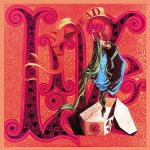
Live/Dead
2 吉他谱
1 求谱
10 拨片
Live/Dead专辑介绍
乐队于1964年组建。起初乐队的名字叫“Warlocks”,后来乐队的成员开始服用LSD兵书;并开创了“迷幻摇滚”的先河。同时他们还成为第一支在吸毒后即兴表演的乐队。也是在这一时期乐队改名为“The Grateful Dead”。1966年乐队已在地下乐坛名声显赫,他们的音乐无所不包从小调到硬摇滚。1967年夏天乐队参加了雷蒙德音乐节,并被誉为音乐界上最好的乐队。同年乐队发行了第一张同名专辑,被称为用布鲁斯演唱的迷幻摇滚。1968年因与签约公司关系不好而使得第二张专辑《Anthem of the Sun》并不出色。1967年到1969年之间乐队进行了巡演并推出了第三张专辑《Aoxomoxoa》成绩依然不理想。1970年推出了现场双专辑《Live/Dead》,《Workingman’s Dead》及《American Beauty》均获得了成功,其中后两张专辑是乐队历史上销量最大的专辑。在此后乐队及乐队成员都出了许多专辑,并一直进行着巡演。在这期间的专辑《In the Dark》被认为是最好的作品,并为乐队赢得了第一首热门歌曲“Touch of Gery”。1995年Jerry Garcia去世,乐队宣布解散。The Grateful Dead系统的把自由自在的一种音乐形式引入了摇滚乐,他们的音乐表明了他们在不断的发展自己的音乐理想。
这张专辑在滚石杂志选出的500张历代最强专辑中排名第244位。
The Grateful Dead's fourth title was likewise their first extended concert recording. Spread over two LPs, Live/Dead (1969) finally was able to relay the intrinsic sonic magnificence of a Dead show in real time. Additionally, it unleashed several key entries into their repertoire, including the sidelong epic and Deadhead anthem"Dark Star" as well as wailing and otherwise electrified acidic covers of the Rev. Gary Davis blues standard "Death Don't Have No Mercy" and the R&B rave-up "(Turn on Your) Lovelight." Finally, the conundrum of how to bring a lengthy performance experience to the listener has been solved. The album's four sides provided the palette from which to replicate the natural ebb and flow of a typical Dead set circa early 1969. Tomes have been written about the profound impact of "Dark Star" on the Dead and their audience. It also became a cultural touchstone signifying that rock music was becoming increasingly experimental by casting aside the once-accepted demands of the short, self-contained pop song. This version was recorded on February 27, 1969, at the Fillmore West and is presented pretty much the way it went down at the show. The same is true of the seven remaining titles on Live/Dead. The rousing rendition of "St. Stephen" reinvents the Aoxomoxoa (1968) prototype with rip-roaring thunder and an extended ending which slams into an instrumental rhythmic excursion titled "The Eleven" after the jam's tricky time signature. The second LP began with a marathon cover of "(Turn on Your) Lovelight," which had significant success for both Bobby "Blue" Bland and Gene Chandler earlier in the decade. With Ron "Pigpen" McKernan at the throttle, the Dead barrel their way through the work, reproportioning and appointing it with fiery solos from Garcia and lead vocal raps courtesy of McKernan. "Death Don't Have No Mercy" is a languid noir interpretation of Rev. Gary Davis' distinct Piedmont blues. Garcia's fretwork smolders as his solos sear through the melody. Likewise notable is the criminally underrated keyboard work of Tom Constanten, whose airy counterpoint rises like a departing spirit from within the soul of the song. The final pairing of "Feedback" -- which is what is sounds like it might be -- with the "lowering down" funeral dirge "And We Bid You Goodnight" is true to the way that the band concluded a majority of their performances circa 1968-1969. They all join in on an a cappella derivative of Joseph Spence and the Pinder Family's traditional Bahamian distillation. Few recordings have ever represented the essence of an artist in performance as faithfully as Live/Dead. It has become an aural snapshot of this zenith in the Grateful Dead's 30-year evolution and as such is highly recommended for all manner of enthusiasts. The 2001 remastered edition that was included in the Golden Road (1965-1973) (2001) box set tacks on the 45 rpm studio version of "Dark Star" as well as a vintage radio advert for the album.